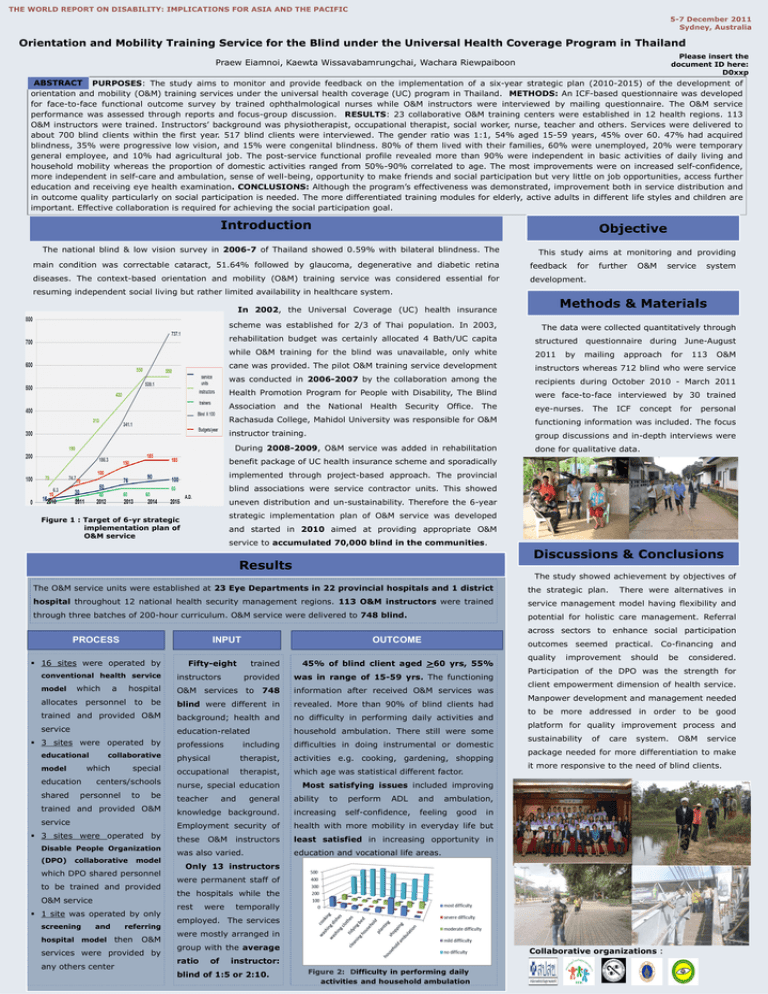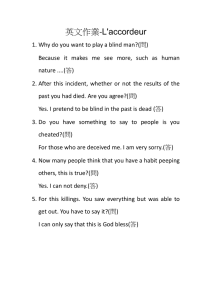Document 17551069
advertisement

THE WORLD REPORT ON DISABILITY: IMPLICATIONS FOR ASIA AND THE PACIFIC 5-7 December 2011 Sydney, Australia Orientation and Mobility Training Service for the Blind under the Universal Health Coverage Program in Thailand Please insert the document ID here: D0xxp Praew Eiamnoi, Kaewta Wissavabamrungchai, Wachara Riewpaiboon ABSTRACT PURPOSES: The study aims to monitor and provide feedback on the implementation of a six-year strategic plan (2010-2015) of the development of orientation and mobility (O&M) training services under the universal health coverage (UC) program in Thailand. METHODS: An ICF-based questionnaire was developed for face-to-face functional outcome survey by trained ophthalmological nurses while O&M instructors were interviewed by mailing questionnaire. The O&M service performance was assessed through reports and focus-group discussion. RESULTS: 23 collaborative O&M training centers were established in 12 health regions. 113 O&M instructors were trained. Instructors’ background was physiotherapist, occupational therapist, social worker, nurse, teacher and others. Services were delivered to about 700 blind clients within the first year. 517 blind clients were interviewed. The gender ratio was 1:1, 54% aged 15-59 years, 45% over 60. 47% had acquired blindness, 35% were progressive low vision, and 15% were congenital blindness. 80% of them lived with their families, 60% were unemployed, 20% were temporary general employee, and 10% had agricultural job. The post-service functional profile revealed more than 90% were independent in basic activities of daily living and household mobility whereas the proportion of domestic activities ranged from 50%-90% correlated to age. The most improvements were on increased self-confidence, more independent in self-care and ambulation, sense of well-being, opportunity to make friends and social participation but very little on job opportunities, access further education and receiving eye health examination. CONCLUSIONS: Although the program’s effectiveness was demonstrated, improvement both in service distribution and in outcome quality particularly on social participation is needed. The more differentiated training modules for elderly, active adults in different life styles and children are important. Effective collaboration is required for achieving the social participation goal. Introduction Objective The national blind & low vision survey in 2006-7 of Thailand showed 0.59% with bilateral blindness. The This study aims at monitoring and providing main condition was correctable cataract, 51.64% followed by glaucoma, degenerative and diabetic retina feedback diseases. The context-based orientation and mobility (O&M) training service was considered essential for development. resuming independent social living but rather limited availability in healthcare system. for further O&M service system Methods & Materials In 2002, the Universal Coverage (UC) health insurance scheme was established for 2/3 of Thai population. In 2003, The data were collected quantitatively through rehabilitation budget was certainly allocated 4 Bath/UC capita structured questionnaire during June-August while O&M training for the blind was unavailable, only white 2011 cane was provided. The pilot O&M training service development instructors whereas 712 blind who were service was conducted in 2006-2007 by the collaboration among the recipients during October 2010 - March 2011 Health Promotion Program for People with Disability, The Blind were face-to-face interviewed by 30 trained Association and the National Health Security Office. The eye-nurses. Rachasuda College, Mahidol University was responsible for O&M functioning information was included. The focus instructor training. group discussions and in-depth interviews were During 2008-2009, O&M service was added in rehabilitation by mailing The approach ICF for concept 113 for O&M personal done for qualitative data. benefit package of UC health insurance scheme and sporadically implemented through project-based approach. The provincial blind associations were service contractor units. This showed uneven distribution and un-sustainability. Therefore the 6-year strategic implementation plan of O&M service was developed Figure 1 : Target of 6-yr strategic implementation plan of O&M service and started in 2010 aimed at providing appropriate O&M service to accumulated 70,000 blind in the communities. Results Discussions & Conclusions The study showed achievement by objectives of The O&M service units were established at 23 Eye Departments in 22 provincial hospitals and 1 district the strategic plan. hospital throughout 12 national health security management regions. 113 O&M instructors were trained service management model having flexibility and through three batches of 200-hour curriculum. O&M service were delivered to 748 blind. potential for holistic care management. Referral PROCESS INPUT 16 sites were operated by conventional health service model which a hospital allocates personnel to be trained and provided O&M service 3 sites were operated by educational which model education shared collaborative special centers/schools personnel to be across sectors to enhance social participation OUTCOME Fifty-eight outcomes seemed practical. Co-financing and trained 45% of blind client aged >60 yrs, 55% provided was in range of 15-59 yrs. The functioning O&M services to 748 information after received O&M services was blind were different in revealed. More than 90% of blind clients had background; health and no difficulty in performing daily activities and education-related household ambulation. There still were some professions including difficulties in doing instrumental or domestic physical therapist, activities e.g. cooking, gardening, shopping occupational therapist, which age was statistical different factor. instructors nurse, special education teacher and general ability to perform ADL and increasing service Employment security of health with more mobility in everyday life but these O&M least satisfied in increasing opportunity in Disable People Organization (DPO) collaborative model which DPO shared personnel to be trained and provided O&M service 1 site was operated by only screening and hospital model referring then O&M services were provided by any others center was also varied. improvement should self-confidence, feeling good Manpower development and management needed to be more addressed in order to be good platform for quality improvement process and sustainability of care system. in education and vocational life areas. temporally employed. The services were mostly arranged in ratio of instructor: blind of 1:5 or 2:10. service it more responsive to the need of blind clients. the hospitals while the group with the average O&M package needed for more differentiation to make were permanent staff of were considered. client empowerment dimension of health service. Only 13 instructors rest be Participation of the DPO was the strength for ambulation, knowledge background. instructors quality Most satisfying issues included improving trained and provided O&M 3 sites were operated by There were alternatives in Collaborative organizations :


